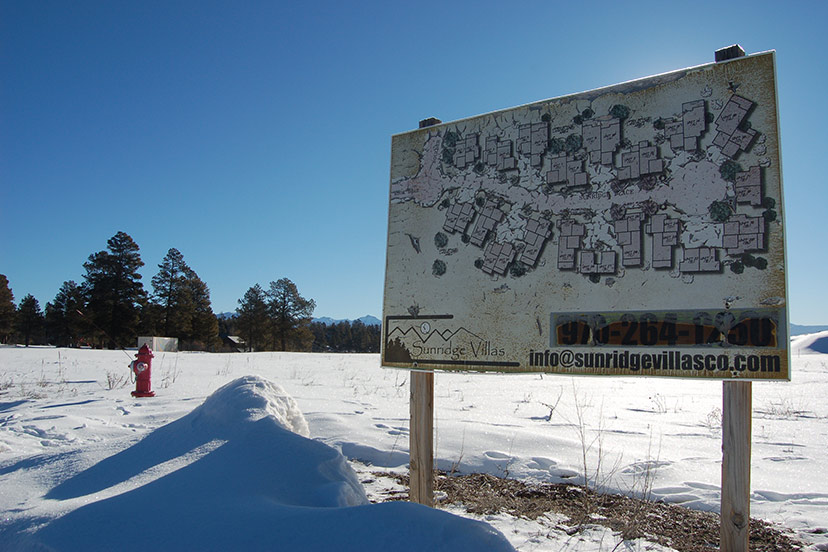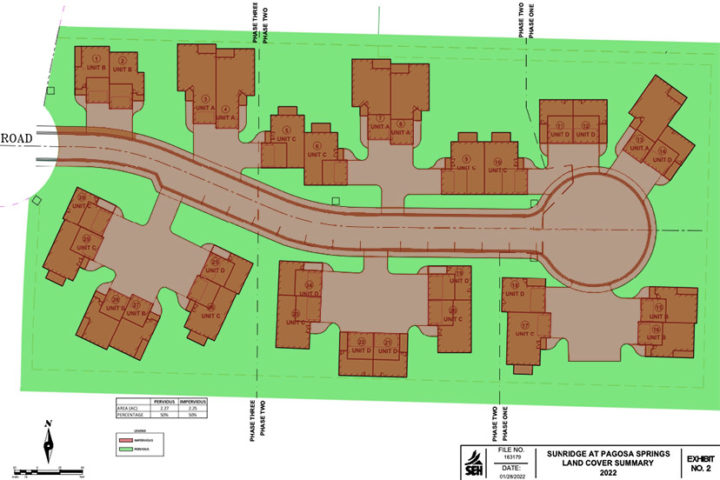I woke up from a slightly unsettling dream on Saturday morning. In the dream, Pagosa Springs had become a full-blown city, with multi-story buildings and streets full of cars and trucks. The sidewalks were crammed with tourists, and my family and I were trying to escape from the crowds, and also trying to locate a bus stop. I woke up while we were still wandering, feeling lost and surrounded by strangers.
I climbed out of bed, got dressed and made some coffee… and then warmed up the car and got my camera ready for a trip uptown. I had one task on my Saturday schedule: to take some photos in Aspen Village.
Photos of the numerous vacant parcels there.
I had written about Aspen Village previously in the Daily Post. In fact, one of the very first real estate articles we published, back in 2005 or 2006, had been written by local journalist Leanne Goebel about this unusual (for Pagosa) subdivision — an intentional mix of commercial and residential parcels, which would theoretically produce a pedestrian-friendly, “Live, Work, Play” neighborhood, similar to the one that had developed historically in downtown Pagosa Springs decades earlier. The subdivision measures about 90 acres, approximately one quarter the size of the historical downtown.
When The Aspen Village subdivision was platted and then developed — with all streets, sidewalks, and utilities installed, and with three access points onto Highway 160 — Pagosa Springs was just coming off 15 years of rather unbelievable population growth. As far as the developers of Aspen Village could foresee, the commercial and residential parcels would sell, and build out, in no time at all.
Then 2008 arrived. Commercial and residential construction ground to a halt, and Archuleta County saw a population decrease over the next few years.
15 years later, about 80 percent of the parcels in Aspen Village are still vacant.

Last week, the Town Planning Commission conducted a public hearing on the topic of ‘Sunridge of Pagosa Springs’ — a proposed development of 30 town homes on about 4.5 acres near the Centerpoint Church in Aspen Village.
The Sunridge Villas Townhomes were originally approved in 2006-2007 as a Planned Unit Development. After the development failed to move forward, the Town released all bonding in 2013, with the development installing some utilities before the project ceased. I understand the property is under new ownership… and considering that Pagosa home prices have more than doubled over the past 10 years, perhaps the project will move forward, this time around.
From the application submitted to the Town Planning Department:
The buildings will vary from 1 story to 3 stories and from approximately 1,200 square feet to 2,400 square feet. The townhomes will be accessed from Boulder Drive via a private street (asphalt with concrete curb & gutter), with sidewalks on both sides, which will be maintained by the Home Owner’s Association…
The proposed units will provide much needed housing to the already established Aspen Village neighborhood that continues to grow into a livable, walkable community…
Here’s a weathered and faded real estate sign for the project, adjacent to Rock Road, that looks like it might date back to 2007.
I’m talking about Aspen Village in this editorial series, for what might be good reasons.
The Planning Commission recommended approval of ‘Sunridge of Pagosa Springs’ at their March 8 public hearing. I attended the hearing, and don’t recall anyone using the terms “workforce housing” or “affordable housing” during the discussion, so I assume these town homes will not be particularly affordable.
The term ‘workforce housing’ definitely belongs in this editorial series because the Town government has submitted an application for a $3 million “affordable housing” grant, to the Colorado Department of Local Affairs (DOLA) last week. DOLA exists for a few reasons, one of which is to give grants of taxpayer money to local governments, for projects that will supposedly make communities more livable. DOLA has supported numerous Town projects in the past, as well as community projects such as Pagosa Peak Open School, located in Aspen Village.
When Town Planning Director James Dickhoff presented his grant idea to the Town Council on March 1, he proposed that the $3 million (if awarded) would be used to purchase and begin development of a 35-acre parcel located some ways beyond the east end of downtown, located between Buckskin Towing and the Strohecker asphalt plant. That 35-acre parcel has no highway access, no streets, no utilities. It’s just raw land.
Mr. Dickhoff presented this same idea to the Town Planning Commission, a week later.
A Town Council member later told me that the grant money could conceivably be used in a different location, if appropriate. I took that comment to heart.
Neither public presentation by Mr. Dickhoff included detailed estimates of what could feasibly be accomplished with $3 million on a completely undeveloped parcel. This concerns me. Based on my past experiences with governments in Archuleta County, I start feeling very uncomfortable when government officials start writing grants without sharing any financial information with the public.
What do we know about the Town’s recent experiences with development projects? Well, we know that the Town created a new $2 million debt repairing four blocks of South 8th Street, a few years back. That was an existing street, with existing sidewalks on the east side of the street. The project involved tearing up the old asphalt, repairing the roadbed, laying new asphalt, and adding a sidewalk on the west side. As far as I know, it did not include the installation of any utilities.
And we know that everything is more expensive in 2022 than it was in 2017. How many blocks of a brand new street, including the installation of utilities, could the Town build with $3 million, in 2022?
Two blocks, maybe?
But the Town doesn’t own the parcel yet. It’s on the market currently for $1.2 million. So we might ask: how many blocks of new streets, plus utilities, could the Town build with $1.8 million? And let’s not forget about two new highway intersections… because the parcel in question has no highway access yet. (I hear CDOT access has gotten very expensive lately.)
So many questions, to which we have no answers.
But we do have some answers about a very different subdivision, on the other side of town. An existing 90-acre subdivision, which is currently about 80 percent vacant. A neighborhood purposefully designed for walking and biking.
Aspen Village.



